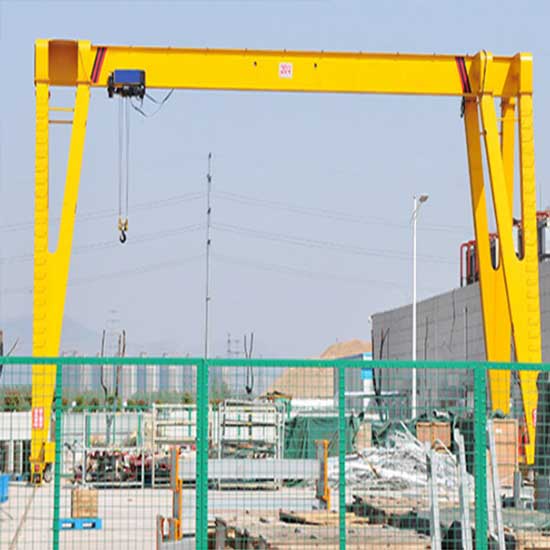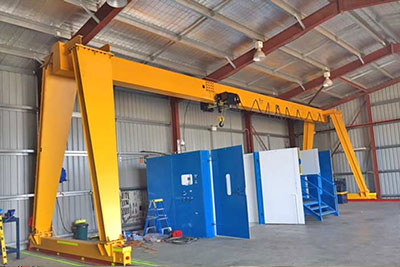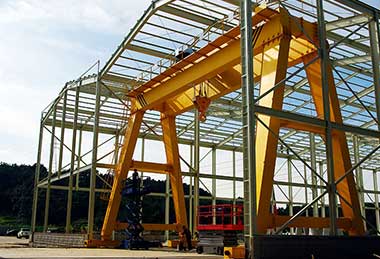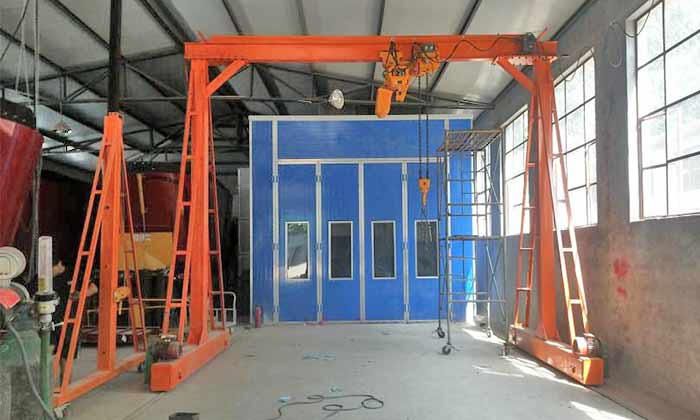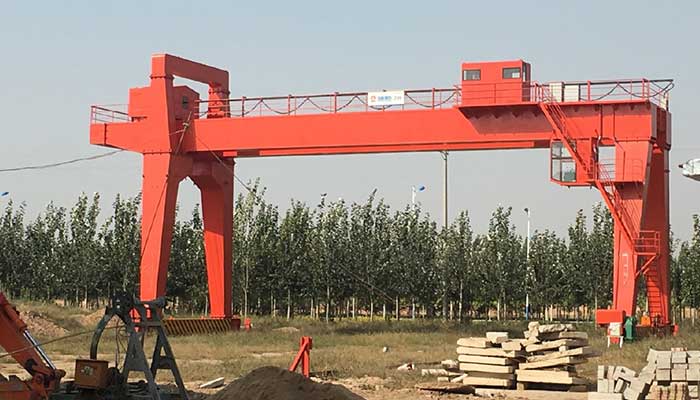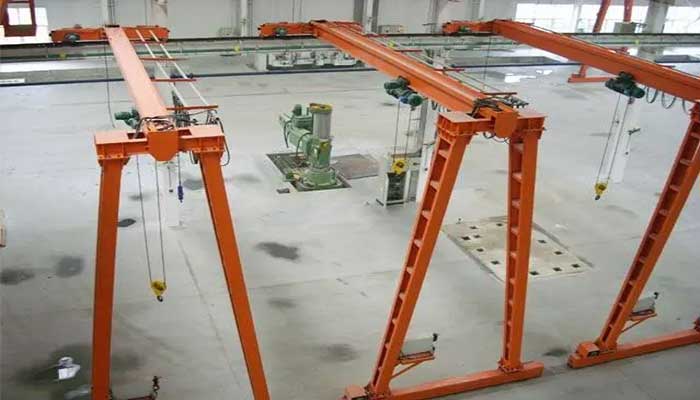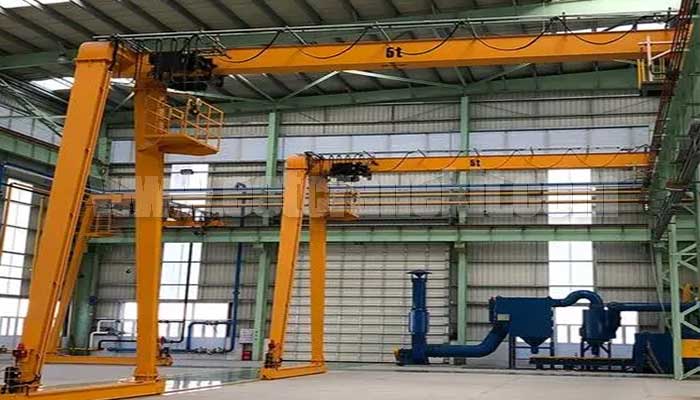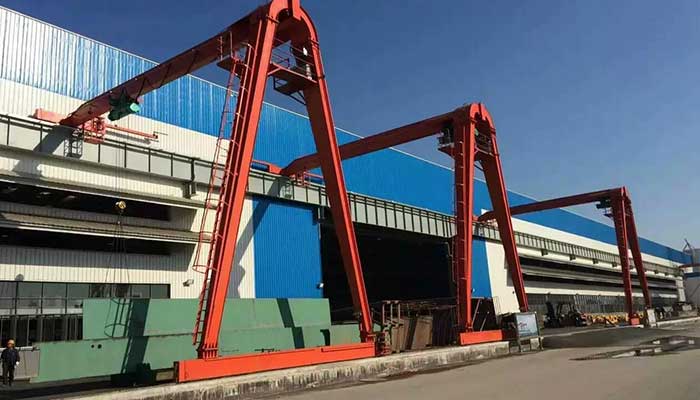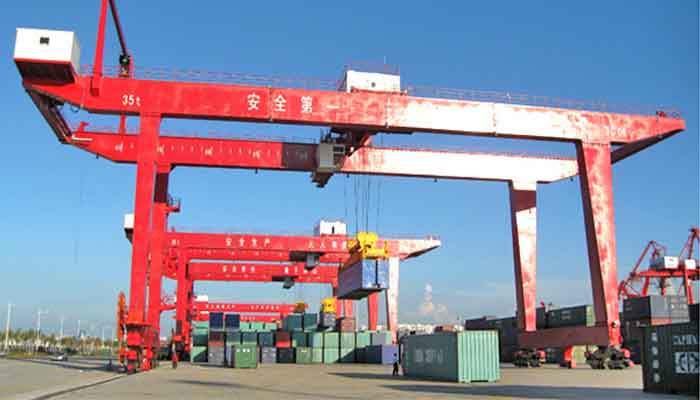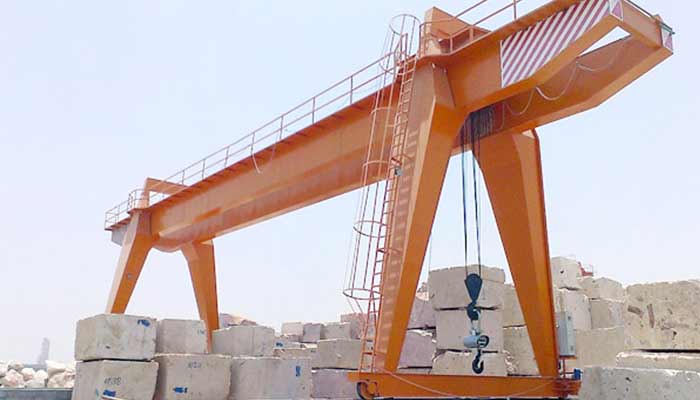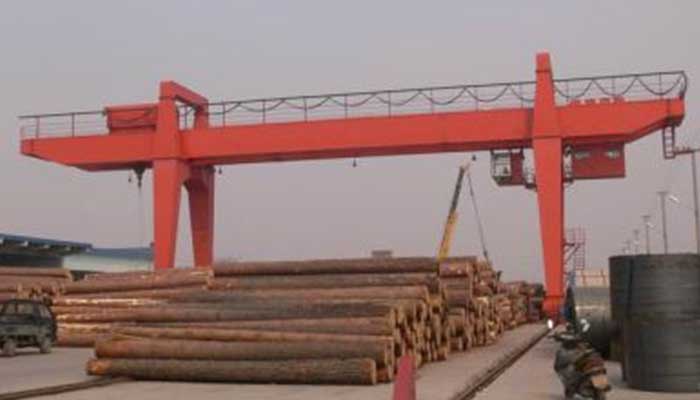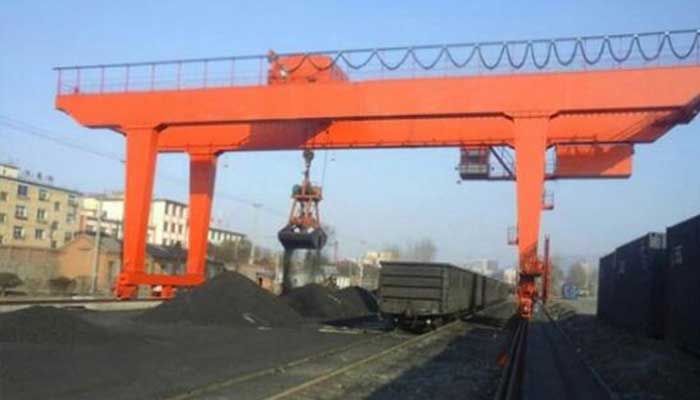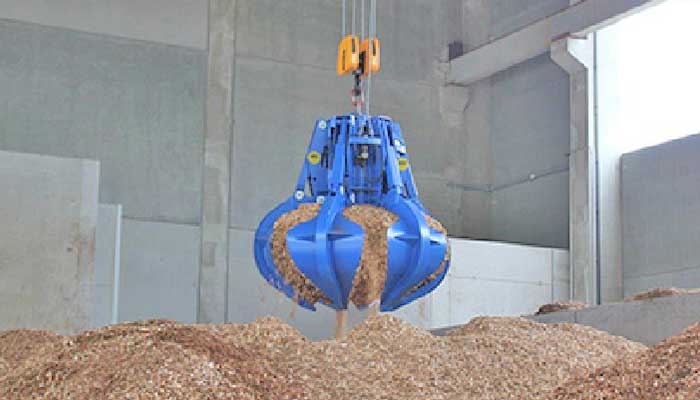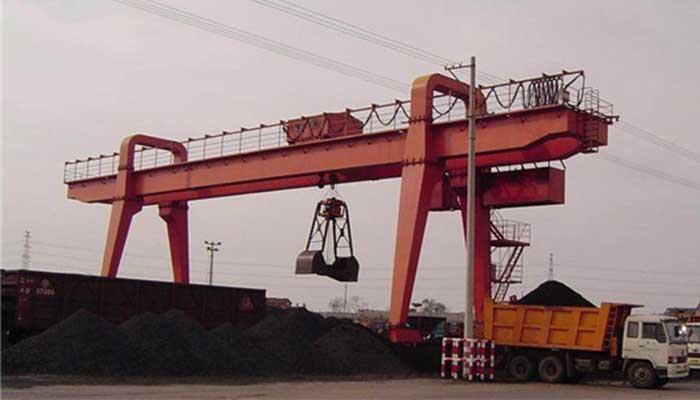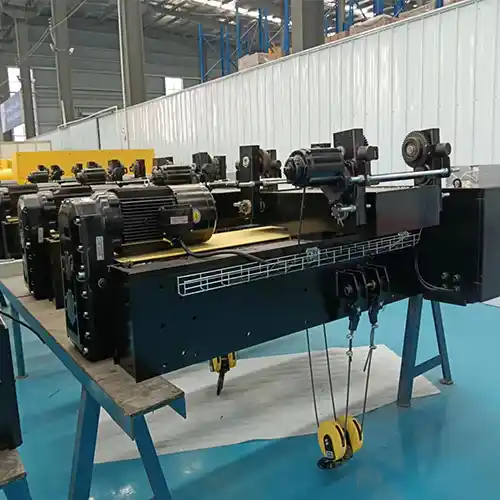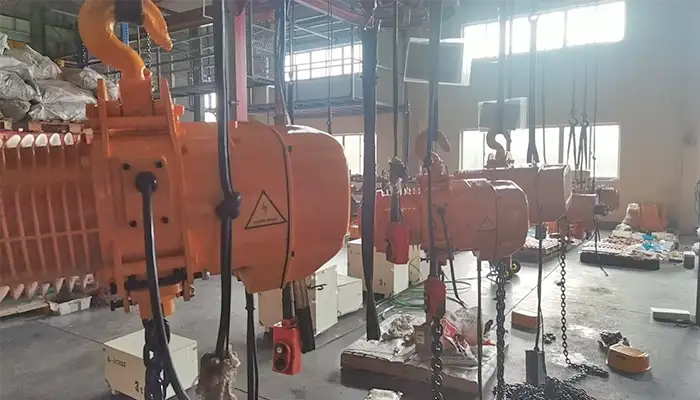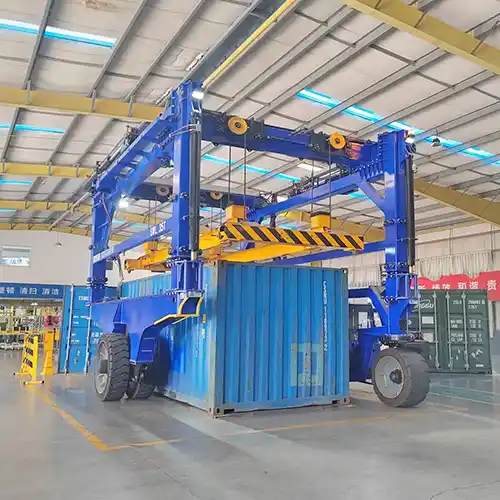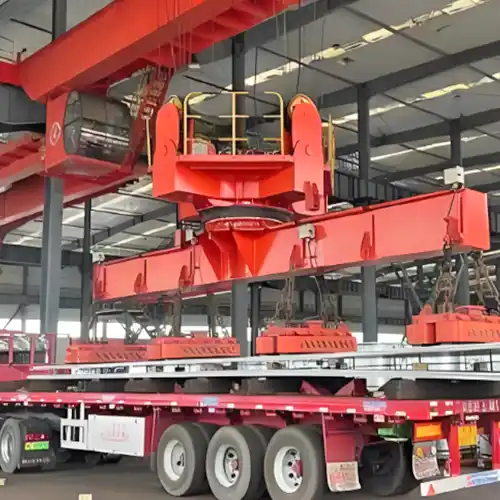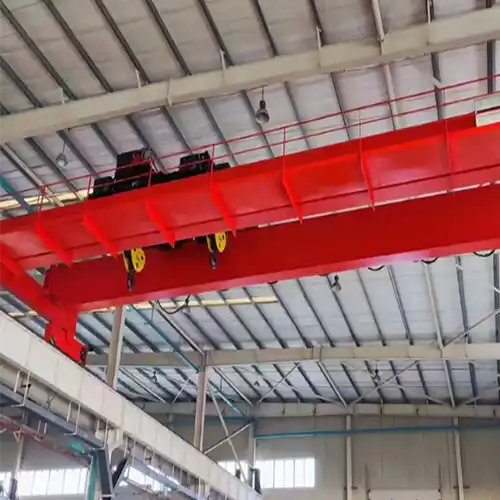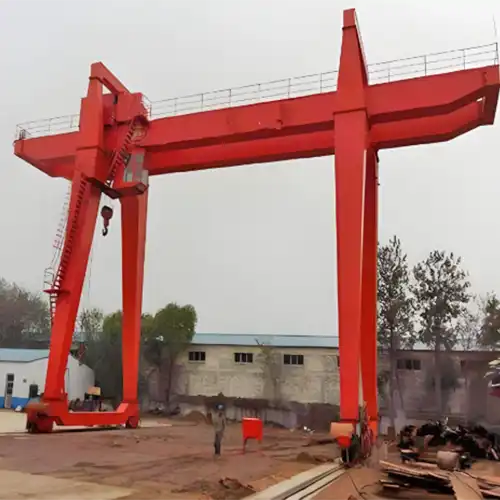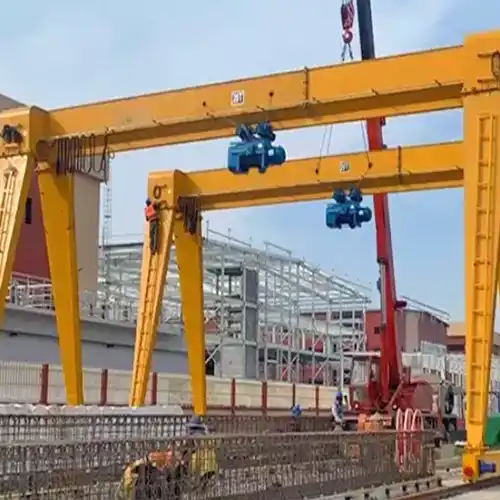Gantry Cranes on Tracks 3 Ton to 100 Ton| Types, Uses & Selection
Gantry cranes on tracks for sale, a guide on various types of gantry crane on tracks used for different industrial applications to select your crane design.
Category: Featured
Your Trusted Gantry Crane on Tracks Manufacturer & Supplier
Gantry Cranes on Tracks 3 Ton to 100 Ton | Types, Uses & Selection
Gantry cranes on tracks for sale, a guide on various types of gantry crane on tracks used for different industrial applications to select your crane design. Welcome to the world of gantry cranes on tracks, where precision meets power in the realm of material handling. In this comprehensive guide, we'll delve into the definition, purpose, and myriad applications of these engineering marvels that have become the backbone of various industries.
Gantry cranes, at their core, are industrial lifting machines designed for the seamless movement and precise placement of heavy loads. What sets gantry cranes on tracks apart is their integration with a track-based system, allowing for enhanced mobility and accuracy during operations.
The term gantry refers to the framework that supports the crane's lifting mechanism. This structure is mounted on wheels or other mechanisms that run along tracks, providing a guided path for the crane's movement. The incorporation of tracks ensures a stable and controlled traversal, making gantry cranes on tracks indispensable in environments where accuracy and efficiency are paramount.
Applications in Material Handling
The scope of industries relying on gantry cranes on tracks is vast, reflecting the versatility and adaptability of these machines. From bustling ports to precision-demanding construction sites, gantry cranes on tracks have found their place in various material handling operations.
Industries Utilizing Gantry Cranes on Tracks:
- Shipping and Ports:Gantry cranes are the workhorses of container handling in busy ports. Their ability to traverse tracks facilitates the efficient loading and unloading of containers from ships, streamlining logistics in the maritime industry.
- Manufacturing and Construction:In manufacturing plants and construction sites, gantry cranes on tracks play a crucial role in lifting and placing heavy machinery, steel components, and precast concrete elements with precision.
- Mining and Resources:Customized gantry cranes are employed in mining operations to handle substantial loads of ores and minerals. The track-based mobility ensures optimal positioning in mining environments.
- Automotive and Steel Industry:Gantry cranes are utilized in the automotive sector for handling large components and in steel plants for the efficient movement of heavy steel coils.
Benefits of Gantry Cranes:
- Precision Handling:The guided movement along tracks allows gantry cranes to position loads with utmost precision, reducing the margin of error in critical operations.
- Enhanced Mobility:The track system provides a designated path for the crane, optimizing mobility and ensuring efficient coverage of the working are
- Versatility:From container terminals to manufacturing floors, gantry cranes on tracks are adaptable to diverse settings, making them a versatile solution for various material handling needs.
As we embark on this exploration of gantry cranes on tracks, we'll delve deeper into the types, specialized applications, and innovative features that make these machines the backbone of modern industrial processes. Join us in uncovering the intricacies of gantry cranes, where efficiency meets engineering excellence.
Navigating the Landscape of Gantry Cranes on Tracks: Single vs. Double Girder Dynamics
In our exploration of gantry cranes on tracks, we delve into two distinct categories: the nimble Single Girder Gantry Crane and its robust counterpart, the Double Girder Gantry Crane. Each variant is engineered to meet specific demands, offering a spectrum of features and capabilities tailored to diverse industrial applications.
Single Girder Gantry Crane
Features and Benefits:
- Streamlined Design:The hallmark of single girder gantry cranes is their straightforward design, featuring a single horizontal beam. This simplicity enhances ease of maintenance and contributes to cost-effective solutions.
- Agile Maneuverability:Single girder cranes exhibit remarkable agility, navigating confined spaces with ease. Their compact footprint makes them ideal for settings where space optimization is crucial.
- Cost-Efficiency:With fewer structural components, single girder gantry cranes are not only economical to install but also cost-effective to maintain. These cranes strike a balance between performance and affordability.
Ideal Applications and Load Capacities:
- Manufacturing Workshops:Suited for manufacturing environments, single girder gantry cranes efficiently handle moderate loads, transporting machinery, components, and raw materials with precision.
- Warehousing and Distribution:Compact and versatile, these cranes find a natural fit in warehousing and distribution centers. They streamline the movement of goods, optimizing storage and retrieval processes.
- Maintenance Yards:In maintenance and repair yards, where agility is paramount, single girder gantry cranes shine. They excel in swiftly servicing equipment and components.
- Versatile Material Handling:Whether lifting containers, pallets, or bulk materials, single girder gantry cranes prove adaptable to diverse material handling needs.
Double Girder Gantry Crane
Strengths and Applications in Heavy-Duty Settings:
- Heavy-Duty Lifting:Double girder gantry cranes are designed for heavy-duty lifting, making them indispensable in settings where substantial loads need to be handled with precision.
- Stability and Strength:The dual girder configuration enhances stability and strength, allowing these cranes to tackle demanding tasks in industries such as steel manufacturing, shipbuilding, and large-scale construction.
- Extended Span Capacities:Double girder cranes are engineered for extended spans, making them suitable for covering large areas in facilities like warehouses, storage yards, and expansive manufacturing plants.
Comparison with Single Girder Cranes:
- Load Capacity:The primary distinction lies in load capacity, where double girder cranes excel in handling heavier loads compared to their single girder counterparts.
- Height Clearance:Double girder cranes, with their elevated design, offer superior hook height, providing more vertical space for lifting operations compared to single girder cranes.
- Complexity and Cost:While double girder cranes offer unparalleled strength, their design complexity may lead to higher upfront costs and maintenance expenses compared to the simpler single girder cranes.
In the next segment, we'll further unravel the unique features of double girder gantry cranes, exploring their pivotal role in heavy-duty lifting and dissecting their applications across diverse industrial landscapes. Join us as we continue our journey through the world of gantry cranes on tracks.
Navigating the Spectrum of Gantry Cranes on Tracks: Light Rail to Heavy-Duty Prowess
As our exploration of gantry cranes on tracks continues, we now shift our focus to two distinctive categories: the nimble Light Rail Traveling Gantry Crane and the powerhouse Heavy-Duty Gantry Crane. These variants cater to specific industrial demands, showcasing a diverse range of characteristics and applications.
Light Rail Traveling Gantry Crane
Characteristics and Use Cases:
- Streamlined Mobility:Light Rail Traveling Gantry Cranes are characterized by their agility and streamlined mobility. These cranes effortlessly navigate along light rail systems, making them ideal for environments where precision is crucial.
- Compact Workspaces:Designed for compact workspaces, these cranes excel in settings where spatial constraints demand efficient material handling solutions. Their ability to traverse light rails ensures optimal coverage even in confined areas.
- Ease of Maneuverability:With a focus on simplicity and ease of maneuverability, these cranes are adept at efficiently lifting and transporting loads in industries requiring nimble and precise operations.
Advantages in Compact Workspaces:
- Optimized Footprint:Light Rail Traveling Gantry Cranes boast a compact footprint, allowing them to operate efficiently in spaces where traditional cranes may face challenges.
- Quick Positioning:The light rail system facilitates swift and precise positioning of the crane. This feature is particularly advantageous in applications where rapid material handling is essential.
- Enhanced Efficiency:In industries such as workshops, small-scale manufacturing, and assembly lines, the efficiency of light rail traveling gantry cranes lies in their ability to seamlessly integrate into limited spaces without compromising on performance.
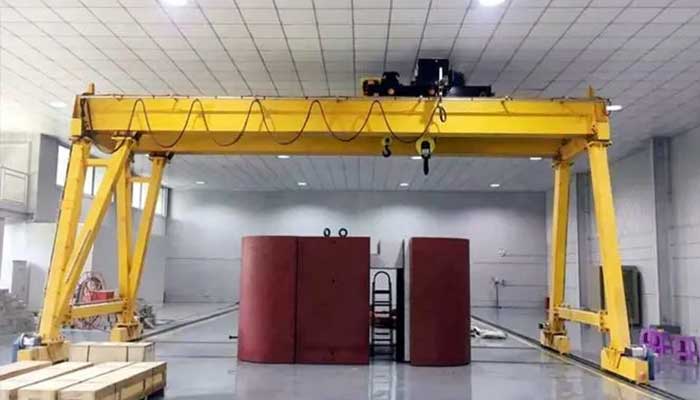
Heavy-Duty Gantry Crane on Tracks
Heavy-Duty Gantry Crane
Design Considerations for Handling Heavier Loads:
- Robust Structural Design:Heavy-Duty Gantry Cranes are engineered with a robust structural design to withstand the immense forces associated with lifting and moving heavier loads. This often involves the use of double girders and reinforced components.
- High Load Capacities:These cranes are designed with a focus on high load capacities, making them indispensable in industries dealing with substantial weights, such as steel manufacturing, shipyards, and heavy machinery production.
- Advanced Lifting Mechanisms:Heavy-duty gantry cranes are equipped with advanced lifting mechanisms, including powerful hoists and trolleys, to ensure controlled and secure handling of heavy and often irregularly shaped loads.
Applications in Industries Requiring Robust Lifting Solutions:
- Steel Manufacturing:Heavy-duty gantry cranes play a pivotal role in the steel industry, handling tasks such as moving and positioning large steel coils, slabs, and other hefty components with precision.
- Shipbuilding and Ports:In shipyards and ports, heavy-duty gantry cranes are essential for lifting and placing heavy ship components, containers, and other maritime-related loads.
- Heavy Machinery Production:Industries involved in the manufacturing of heavy machinery and equipment benefit from the strength and reliability of heavy-duty gantry cranes for efficient material handling.
In the upcoming section, we'll explore the intriguing dynamics of Full Gantry Cranes versus Semi-Gantry Cranes, unraveling their unique features and applications in the industrial landscape. Join us as we navigate the diverse spectrum of gantry cranes on tracks.
Navigating Gantry Cranes on Tracks: Full vs. Semi - Configurations Unveiled
In our journey through the diverse landscape of gantry cranes on tracks, we now turn our attention to two unique configurations: the Full Gantry Crane and its counterpart, the Semi-Gantry Crane. Each configuration brings its own set of distinct features, offering flexibility and efficiency in different industrial scenarios.
Full Gantry Crane vs. Semi-Gantry Crane
Distinct Features and Use Cases:
Full Gantry Crane: Features:
- Supported by four legs or columns, creating a complete, standalone structure.
- Offers full coverage over the working are
- Designed for handling heavy loads and providing maximum stability.
Use Cases:
- Ports and Container Yards:Full gantry cranes shine in port environments, efficiently loading and unloading containers from ships due to their high load capacities and expansive coverage.
- Steel Mills:In steel mills, where the movement of large and heavy steel components is commonplace, full gantry cranes provide the required strength and stability for seamless operations.
Semi-Gantry Crane: Features:
- Supported by one end on a runway or support structure, while the other end moves on wheels along the ground.
- Offers partial coverage, making it suitable for applications where only specific areas need crane access.
- Provides flexibility in design and space utilization.
Use Cases:
- Assembly Lines:Semi-gantry cranes are well-suited for assembly lines where they can traverse specific areas, lifting and placing components with precision.
- Material Storage Yards:In outdoor storage yards, semi-gantry cranes efficiently handle materials within a designated area, optimizing space and providing targeted lifting capabilities.
Flexibility and Efficiency in Different Configurations:
Flexibility in Full Gantry Cranes:
- Full gantry cranes offer a broad range of flexibility due to their ability to cover the entire working areThis makes them suitable for applications requiring extensive coverage and handling heavy loads.
- Their four-legged structure provides stability, allowing them to efficiently handle diverse loads in various industrial settings.
Efficiency in Semi-Gantry Cranes:
- Semi-gantry cranes are designed for targeted efficiency in specific areas. Their ability to move along a fixed runway while utilizing wheels on the other end offers a balance of coverage and space optimization.
- These cranes are often chosen for applications where only a portion of the workspace requires lifting capabilities. This targeted approach enhances efficiency in material handling operations.
As we unravel the dynamics of full and semi-gantry configurations, it becomes clear that the choice between the two depends on the specific requirements of the industrial application. In the following section, we'll explore how indoor and outdoor environments influence the design and functionality of gantry cranes on tracks. Join us as we continue to navigate the intriguing world of gantry cranes.
A frame gantry cranes on tracks vs. U frame gantry cranes on tracks
Indispensable Structures: A-Frame vs. U-Frame Gantry Cranes on Tracks
In the realm of gantry cranes on tracks, two distinct structural configurations stand out: A-Frame and U-Frame Gantry Cranes. These designs play a crucial role in determining the crane's capabilities, adaptability, and the nature of loads they are best suited to handle. Let's delve into the characteristics of A-Frame and U-Frame Gantry Cranes on tracks to understand their unique features and applications.
A-Frame Gantry Cranes on Tracks:
Distinct Features:
- A-Frame Structure:A-Frame Gantry Cranes derive their name from the distinctive A-shaped structure that forms the main frame of the crane. This design provides stability and structural integrity to the crane.
- Single Leg on Each Side:The A-frame configuration consists of a single leg on each side, converging at the top to create the A-shape. This design minimizes the overall weight of the crane while ensuring robust support.
- Ideal for Light to Medium Loads:A-Frame Gantry Cranes are well-suited for applications involving light to medium loads. The single A-frame structure provides ample strength for these loads without unnecessary complexity.
- Compact Footprint:The A-frame design contributes to a compact footprint, making these cranes suitable for environments with limited space. They are often used in workshops, warehouses, and small manufacturing facilities.
- Ease of Assembly:Due to their simpler design, A-Frame Gantry Cranes are relatively easier to assemble and install. This can be advantageous in situations where rapid deployment is required.
Applications:
- Material Handling in Workshops:A-Frame Gantry Cranes are commonly employed in workshops for tasks such as lifting and moving materials, components, and tools. Their compact size and ease of maneuverability make them ideal for these environments.
- Warehousing Operations:In warehouses with space constraints, A-Frame Gantry Cranes efficiently handle tasks like loading and unloading pallets, organizing inventory, and moving goods within a confined space.
- Assembly Lines:The simplicity and compactness of A-Frame Gantry Cranes make them suitable for specific tasks in assembly lines, particularly where the load requirements are within the light to medium range.
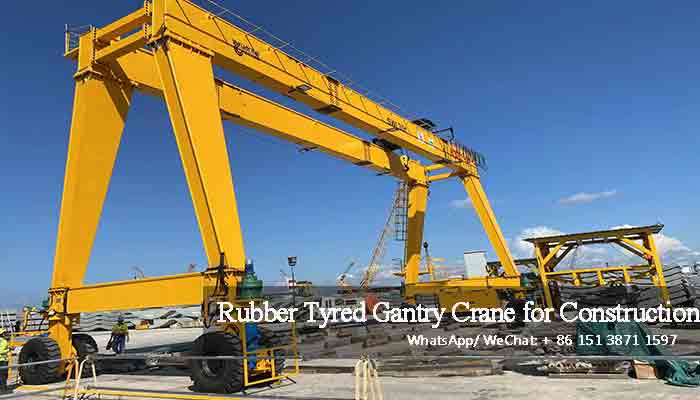
A-Frame Gantry Cranes on Tracks
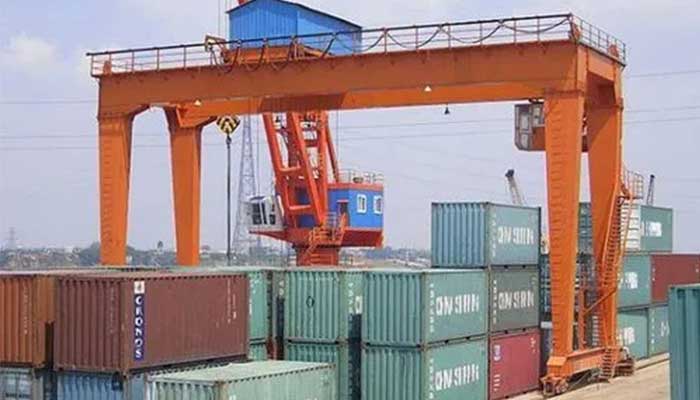
U-Frame Gantry Cranes on Tracks
U-Frame Gantry Cranes on Tracks:
Distinct Features:
- U-Frame Structure:U-Frame Gantry Cranes feature a U-shaped structure, with a horizontal beam connecting the two vertical legs. This configuration provides additional stability and lifting capacity compared to the A-frame design.
- Double Legs on Each Side:Unlike the single leg of A-Frame Cranes, U-Frame Cranes have double legs on each side, contributing to enhanced load-bearing capacity and stability.
- Suited for Heavier Loads:U-Frame Gantry Cranes are designed to handle heavier loads compared to A-Frame cranes. The dual-leg structure imparts greater strength, making them suitable for more demanding applications.
- Extended Span Capability:The horizontal beam in the U-frame design allows for an extended span between the legs. This feature is advantageous when covering a larger operational area is essential.
- Versatility in Load Handling:Due to their increased load capacity, U-Frame Gantry Cranes are versatile and can handle a broader range of loads, making them suitable for diverse industrial applications.
Applications:
- Heavy Manufacturing Processes:U-Frame Gantry Cranes are often employed in heavy manufacturing industries where lifting and transporting substantial materials or components is a regular requirement.
- Steel Mills and Foundries:In environments such as steel mills and foundries, where the loads are heavy and the operational demands are intense, U-Frame Gantry Cranes excel in providing the necessary strength and stability.
- Container Handling in Ports:U-Frame Gantry Cranes are utilized in ports for container handling. Their extended span allows them to straddle rows of containers on ships and efficiently transfer them to the yard.
Considerations for Selection:
- Load Requirements:The primary consideration is the nature of the loads to be handled. A-Frame Cranes are suitable for light to medium loads, while U-Frame Cranes are designed for heavier loads.
- Operational Space:The available operational space plays a crucial role. A-Frame Cranes, with their compact footprint, are ideal for limited spaces, while U-Frame Cranes are better suited for environments with ample space.
- Complexity and Stability:A-Frame Cranes are simpler in design and easier to assemble, whereas U-Frame Cranes offer increased stability and load capacity but may require more intricate assembly and installation.
In essence, the choice between A-Frame and U-Frame Gantry Cranes on tracks hinges on the specific requirements of the application, the nature of the loads, and the available operational space. Each design brings its own set of advantages, allowing industries to tailor their choice based on the demands of their unique material handling scenarios.
Indoor Gantry Cranes on Tracks vs. Outdoor Gantry Cranes on Tracks: Navigating Environments
In the realm of gantry cranes on tracks, the choice between indoor and outdoor configurations introduces a dynamic element, each tailored to specific environmental demands. Let's dissect the characteristics, use cases, and key considerations of Indoor Gantry Cranes and Outdoor Gantry Cranes to understand their distinct roles in material handling.
Indoor Gantry Cranes on Tracks
Distinct Features and Use Cases:
- Enclosed Structure:Indoor gantry cranes are designed with an enclosed structure, providing protection against indoor elements such as dust, humidity, and temperature variations. This makes them suitable for manufacturing facilities, warehouses, and workshops.
- Compact Design:To align with the spatial constraints often found indoors, these cranes feature a compact design, ensuring efficient material handling within confined spaces. They are ideal for applications where precision and agility are crucial.
- Customized Configurations:Indoor gantry cranes can be customized to meet specific indoor requirements. This includes adapting to varying ceiling heights, integrating with existing infrastructure, and incorporating features for optimal performance in indoor settings.
Flexibility and Efficiency in Different Configurations:
- Versatility in Load Handling:Indoor gantry cranes are versatile in handling various loads, ranging from light materials in workshops to heavier machinery in manufacturing environments. Their adaptability makes them a staple in industries with diverse material handling needs.
- Enhanced Safety Measures:Operating in enclosed environments necessitates a heightened focus on safety. Indoor gantry cranes often come equipped with additional safety features, such as collision avoidance systems and precision controls, ensuring a secure operational environment.
- Integration with Production Processes:These cranes seamlessly integrate with indoor production processes, providing a streamlined flow of materials and contributing to the overall efficiency of manufacturing and warehousing operations.
Outdoor Gantry Cranes on Tracks
Distinct Features and Use Cases:
- Weather-Resistant Design:Outdoor gantry cranes are constructed with materials and finishes that withstand outdoor elements, including exposure to sunlight, rain, and varying temperatures. This makes them suitable for applications in shipyards, construction sites, and open-air storage yards.
- Extended Span Capacities:Outdoor gantry cranes often have extended span capacities, allowing them to cover larger areas. This feature is advantageous in outdoor environments where expansive working areas need to be efficiently covered.
- Rugged Construction:The rugged construction of outdoor gantry cranes is designed to handle the challenges posed by outdoor conditions. This includes durable components, corrosion-resistant materials, and robust structural integrity to withstand heavy loads and environmental stressors.
Flexibility and Efficiency in Different Configurations:
- Port Operations:Outdoor gantry cranes play a pivotal role in port operations, handling container loading and unloading tasks with efficiency. Their outdoor design aligns with the demands of maritime logistics, ensuring seamless operations in port terminals.
- Construction Sites:In construction sites, where outdoor gantry cranes are often used for lifting and placing heavy construction materials, their robust design and extended span capacities contribute to the effectiveness of construction projects.
- Open-Air Storage Yards:Outdoor gantry cranes are well-suited for managing materials in open-air storage yards, providing flexibility in moving and organizing materials in vast, outdoor spaces.
Considerations for Selection:
- Environmental Factors:The primary consideration is the environmental conditions of the intended workspace. Indoor cranes prioritize protection against indoor elements, while outdoor cranes are built to withstand the challenges of open-air environments.
- Space Constraints:Indoor gantry cranes are tailored for confined spaces, making them suitable for settings where space optimization is critical. Outdoor gantry cranes, with their extended span capacities, excel in larger, open areas.
- Material Handling Needs:The nature of the materials being handled also influences the choice between indoor and outdoor gantry cranes. Industries with varying material handling needs can select the configuration that aligns with their specific requirements.
In essence, the choice between indoor and outdoor gantry cranes on tracks hinges on the unique demands of the operational environment. Whether navigating confined indoor spaces with precision or handling heavy loads in the vast expanse of the outdoors, gantry cranes on tracks continue to be versatile solutions, each tailored to excel in its designated domain.
Specialized Precision: Container Gantry Cranes
As we navigate the diverse landscape of gantry cranes on tracks, our focus now shifts to specialized variants engineered for specific tasks. First in line is the Container Gantry Crane, a crucial player in the maritime and intermodal logistics arenJoin us as we uncover the design intricacies, operational features, and pivotal role of Container Gantry Cranes in the realm of efficient container handling.
Container Gantry Crane
Design Features for Efficient Container Handling:
- Tall U-Shaped Frame:Container Gantry Cranes are characterized by a distinctive U-shaped frame, allowing them to straddle rows of containers. This design facilitates efficient loading and unloading of containers from ships to the yard and vice vers
- Outreach and Spanning Ability:Equipped with an impressive outreach, these cranes can reach across multiple rows of containers. This spanning ability ensures that containers can be accessed and manipulated within a wide operational area, optimizing yard space.
- Spreader Beams:The lifting mechanism often includes specialized spreader beams designed to securely grip and lift containers. The spreader beams can be adjusted to accommodate different container sizes, ensuring versatility in handling various types of containers.
- Rail-Mounted or Rubber-Tired:Container Gantry Cranes are typically mounted on rails for precise movement along the container yard. Alternatively, some are designed with rubber tires, providing flexibility in navigating the yard without the need for fixed tracks.
Role in Maritime and Intermodal Logistics:
- Efficient Container Transfers:Container Gantry Cranes play a pivotal role in swiftly transferring containers between ships and the container yard. Their ability to straddle rows of containers ensures quick and precise movements during loading and unloading operations.
- Yard Organization and Stacking:These cranes contribute to efficient yard organization by precisely stacking and arranging containers. The U-shaped frame allows for seamless straddling, enabling the crane to position containers with precision in designated storage areas.
- Intermodal Connectivity:Container Gantry Cranes bridge the gap between maritime and inland transportation. They facilitate the smooth transition of containers from ships to trucks or trains, ensuring a seamless intermodal logistics chain.
- High Throughput in Ports:In busy ports, the high throughput of Container Gantry Cranes is essential for handling the constant flow of containers arriving and departing on ships. Their speed and efficiency contribute to the overall productivity of port operations.
As we delve into the specialized world of Container Gantry Cranes, it becomes evident that their design is tailored for the unique demands of container handling in the maritime and intermodal logistics industry. Join us in the next segment as we explore additional specialized gantry cranes, each crafted to excel in handling specific types of loads across various industries.
Precision Craftsmanship: Stone Gantry Cranes
In our continued exploration of specialized gantry cranes, we now turn our attention to the Stone Gantry Crane. Tailored for the unique demands of the stone industry, these cranes exhibit precision in handling substantial stone blocks and slabs. Join us as we unveil the meticulous design features, applications, and pivotal role of Stone Gantry Cranes in quarrying and stone processing.
Stone Gantry Crane
Precision Handling of Stone Blocks and Slabs:
- Heavy-Duty Construction:Stone Gantry Cranes are engineered with a heavy-duty construction to withstand the weight and irregular shapes of stone blocks and slabs. This robust design ensures stability and safety during lifting and transportation operations.
- Specialized Grabbing Mechanism:The lifting mechanism of Stone Gantry Cranes often includes a specialized grabbing mechanism designed to securely grip stone blocks or slabs. This grabber provides precise control during lifting and placement operations.
- Variable Spread and Rotation:To accommodate different sizes and shapes of stone materials, these cranes are equipped with a variable spread and rotation mechanism. This allows for flexible adjustments to ensure a secure grip on stones of varying dimensions.
- Stability-enhancing Features:Stone Gantry Cranes may incorporate features such as sway control systems to minimize any unwanted movement during lifting. This enhances stability and ensures that stones are lifted and transported with utmost precision.
Applications in Quarrying and Stone Processing:
- Quarry Operations:In the quarrying industry, Stone Gantry Cranes play a crucial role in the extraction and transportation of large stone blocks. Their ability to handle heavy loads with precision facilitates efficient quarrying operations.
- Stone Processing Facilities:Once extracted, stones undergo various processing stages. Stone Gantry Cranes are employed in processing facilities for tasks such as cutting, shaping, and transporting processed slabs. The precision of these cranes is essential in maintaining the integrity of the stone.
- Customized Configurations:Stone Gantry Cranes can be customized to suit the specific requirements of different stone materials. The flexibility in their design allows for efficient handling of a variety of stones, including granite, marble, limestone, and more.
- Highly Controlled Placement:The precision of Stone Gantry Cranes comes to the forefront when placing stones in designated locations, whether it be within a processing facility or onto transportation vehicles. Controlled placement ensures the integrity of the stones and minimizes the risk of damage.
In the realm of stone handling, precision is paramount, and Stone Gantry Cranes are designed to meet this demand with finesse. Join us in the next segment as we explore additional specialized gantry cranes, each crafted to excel in handling specific types of loads across various industries.
Log Gantry Cranes in Forestry and Lumber
Our exploration of specialized gantry cranes continues with a focus on Log Gantry Cranes, designed specifically for the forestry and lumber industry. These cranes are crafted to handle the unique challenges of transporting logs with efficiency and precision. Join us as we unveil the features and applications that make Log Gantry Cranes vital in the forestry and lumber sector.
Log Gantry Crane on Tracks
Handling Logs in Forestry and Lumber Industry:
- Robust Construction:Log Gantry Cranes are built with robust structures to withstand the weight and dimensions of logs. This ensures the durability and longevity of the crane under the demanding conditions of the forestry and lumber industry.
- Specialized Grapple Mechanism:The lifting mechanism often features a specialized grapple or claw designed to securely grip logs. This grapple is tailored to the unique characteristics of logs, allowing for efficient lifting and transport without causing damage to the wood.
- Variable Span and Reach:Given the irregular sizes and shapes of logs, Log Gantry Cranes are designed with a variable span and reach. This adaptability allows the crane to handle logs of different lengths and facilitates efficient loading and unloading operations.
- Terrain Adaptability:Log Gantry Cranes on tracks are engineered for adaptability to varied terrains commonly encountered in forestry settings. The track system provides stability and mobility, allowing the crane to navigate through uneven or challenging ground conditions.
Features for Efficient Log Transport:
- Precise Control Systems:Log Gantry Cranes are equipped with precise control systems that enable operators to manipulate the grapple with accuracy. This precision is crucial for efficient log placement and stacking in processing yards.
- Integrated Scales and Measurement Systems:Many Log Gantry Cranes are integrated with scales and measurement systems. This feature allows for the accurate measurement of logs during the handling process, aiding in inventory management and resource optimization.
- High Lifting Capacities:Considering the weight of logs, these cranes boast high lifting capacities. This capability ensures that the crane can handle multiple logs simultaneously, contributing to the efficiency of forestry and lumber operations.
- Safety Features:Safety is paramount in the forestry and lumber industry. Log Gantry Cranes incorporate safety features such as anti-sway systems and load monitoring to prevent accidents and ensure the well-being of operators and workers in the vicinity.
In the heart of the forestry and lumber industry, Log Gantry Cranes on tracks stand as indispensable allies, seamlessly navigating through the challenges of handling logs with precision and efficiency. Join us in the next segment as we explore additional specialized gantry cranes, each tailored to excel in the handling of specific types of loads across diverse industries.
Unearthing Power: Mining Gantry Cranes on Tracks
Our journey through specialized gantry cranes takes us into the rugged terrain of mining operations with a focus on Mining Gantry Cranes on tracks. These robust machines are customized for the unique challenges posed by mining environments, where heavy loads and demanding conditions are the norm. Join us as we delve into the customization and capabilities that make Mining Gantry Cranes essential in the mining industry.
Mining Gantry Crane on Tracks
Customization for Mining Operations:
- Heavy-Duty Design:Mining Gantry Cranes are engineered with a heavy-duty design to tackle the extreme conditions prevalent in mining environments. The robust structure ensures durability and reliability in the face of constant use and exposure to harsh elements.
- Corrosion-Resistant Materials:Given the corrosive nature of certain mining environments, these cranes often incorporate corrosion-resistant materials and coatings. This feature enhances the longevity of the crane components and reduces maintenance requirements.
- Dust and Debris Protection:Mining operations generate significant amounts of dust and debris. Mining Gantry Cranes are equipped with features such as sealed components and protective measures to minimize the impact of dust and debris on the crane's performance.
- Adaptable Track Systems:The track systems of Mining Gantry Cranes are designed to adapt to the uneven and challenging surfaces commonly found in mining areas. This adaptability ensures the crane can traverse the mining site with stability and efficiency.
Handling Heavy Loads in Mining Environments:
- High Load Capacities:The primary function of Mining Gantry Cranes is to handle heavy loads commonly encountered in mining operations. These cranes boast high load capacities, allowing them to lift and transport substantial amounts of ore, minerals, or mining equipment.
- Versatile Lifting Mechanisms:Depending on the specific requirements of mining tasks, these cranes may feature versatile lifting mechanisms. This could include specialized hooks, buckets, or other lifting attachments tailored for the mining industry.
- Precise Positioning:Mining Gantry Cranes are equipped with precise positioning systems to ensure accurate placement of heavy loads. This is crucial in mining operations where precise positioning is essential for tasks such as loading trucks or transporting materials within the mining site.
- Safety Measures:Safety is paramount in mining environments. These cranes incorporate advanced safety features such as overload protection, emergency braking systems, and obstacle detection to safeguard both the crane and personnel working in the vicinity.
In the challenging realm of mining, where the earth's bounty is extracted, Mining Gantry Cranes on tracks stand as stalwart companions, customized to handle the rigors of heavy loads and harsh conditions. Join us in the next segment as we continue our exploration of specialized gantry cranes, each purpose-built for distinct industries and load handling requirements.
Green Energy Lift: Biomass Gantry Cranes on Tracks
Our exploration of specialized gantry cranes takes a sustainable turn as we delve into Biomass Gantry Cranes on tracks. These cranes are crafted for the bioenergy industry, where handling biomass materials efficiently is a key component of green energy production. Join us as we uncover the considerations and features that make Biomass Gantry Cranes essential in the realm of bioenergy.
Biomass Gantry Crane on Tracks
Handling Biomass Materials in Bioenergy Industry:
- Gentle Handling Mechanisms:Biomass Gantry Cranes are designed with features that facilitate the gentle handling of biomass materials. Given the often fragile and varying nature of biomass, the crane's mechanisms prioritize minimizing damage during lifting and transportation.
- Versatile Gripping Attachments:The lifting mechanisms of Biomass Gantry Cranes are equipped with versatile gripping attachments. These may include specialized clamps, buckets, or other gripping devices tailored to efficiently handle different forms of biomass, from wood chips to agricultural residues.
- Dust and Contaminant Control:Biomass materials can generate dust and contaminants during handling. These cranes incorporate measures such as dust suppression systems and sealed components to control the release of particles, ensuring a cleaner and safer working environment.
- Adaptability to Biomass Types:The bioenergy industry deals with a variety of biomass materials, each with its unique characteristics. Biomass Gantry Cranes are adaptable to handle different types of biomass, providing flexibility in operations.
Considerations for Efficient Biomass Handling:
- Efficient Loading and Unloading:Biomass Gantry Cranes are optimized for efficient loading and unloading operations. This includes features such as rapid lifting and lowering mechanisms to minimize downtime and maximize throughput.
- Variable Span and Reach:The variable span and reach of these cranes allow them to cover a wide operational areThis adaptability is essential in biomass facilities where materials may be stored in various configurations and locations.
- Environmental Sustainability:In alignment with the ethos of the bioenergy industry, Biomass Gantry Cranes often incorporate environmentally sustainable features. This may include energy-efficient components, eco-friendly lubricants, and other measures to reduce the overall environmental impact.
- Integration with Biomass Processing Equipment:Biomass Gantry Cranes are designed to seamlessly integrate with other biomass processing equipment. This includes conveyors, shredders, and screening systems, creating a cohesive and efficient biomass handling system.
In the pursuit of green energy, Biomass Gantry Cranes on tracks emerge as vital players, ensuring the efficient and sustainable handling of biomass materials for bioenergy production. Join us in the next segment as we continue our exploration of specialized gantry cranes, each purpose-built for distinct industries and load handling requirements.
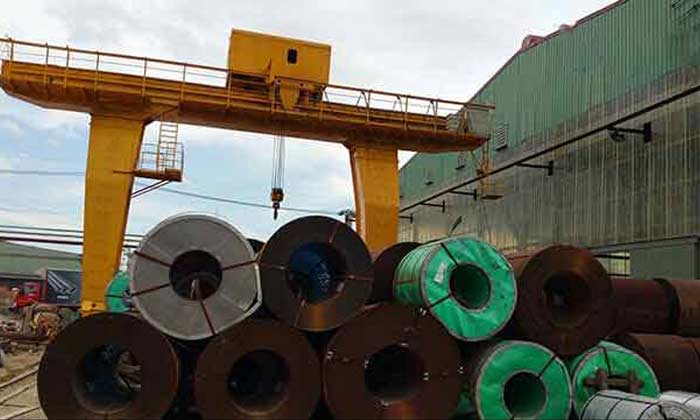
steel coil handling gantry crane on tracks
Forging Strength: Steel Coil Gantry Cranes on Tracks
Our exploration of specialized gantry cranes delves into the heart of steel manufacturing with a focus on Steel Coil Gantry Cranes on tracks. These robust machines are integral to the steel industry, efficiently handling heavy steel coils with precision. Join us as we unravel the role of Steel Coil Gantry Cranes and the considerations that make them indispensable in steel manufacturing plants.
Steel Coil Gantry Crane on Tracks
Role in Steel Manufacturing Plants:
- Continuous Production Support:Steel Coil Gantry Cranes play a pivotal role in the continuous production process of steel manufacturing plants. They are strategically positioned to facilitate the efficient movement of steel coils at various stages of production.
- Integration with Production Lines:These cranes are designed to seamlessly integrate with the production lines of steel manufacturing plants. Their track-mounted configuration allows for precise movements along the production line, ensuring a smooth and streamlined workflow.
- Optimized Storage and Retrieval:In steel manufacturing, storage yards house a vast quantity of steel coils. Steel Coil Gantry Cranes efficiently retrieve coils from storage and position them for processing, contributing to the optimization of storage space and retrieval processes.
Efficient Handling of Heavy Steel Coils:
- High Load Capacities:Steel Coil Gantry Cranes boast high load capacities to handle the weight of heavy steel coils. This capability is essential for lifting and transporting coils from storage to processing stations and throughout the manufacturing facility.
- Specially Designed Hooks or Clamps:The lifting mechanisms of these cranes often feature specially designed hooks or clamps tailored for securely gripping steel coils. This ensures the safe and stable transport of coils without causing damage to the steel surfaces.
- Variable Span and Reach:The variable span and reach of Steel Coil Gantry Cranes allow them to cover a wide operational areThis adaptability is crucial in steel manufacturing plants where coils may vary in size, and the production layout requires flexibility.
- Precision Control Systems:Precision is paramount in handling heavy steel coils. These cranes are equipped with advanced control systems that enable operators to maneuver with precision, placing coils accurately at designated locations within the manufacturing facility.
In the realm of steel manufacturing, where strength and precision are paramount, Steel Coil Gantry Cranes on tracks stand as stalwart companions, ensuring the seamless movement of heavy steel coils throughout the production process. Join us in the next segment as we continue our exploration of specialized gantry cranes, each purpose-built for distinct industries and load handling requirements.
Crafting Precision: Automotive Gantry Cranes
Our journey through specialized gantry cranes takes a detour into the realm of precision engineering with a focus on Automotive Gantry Cranes. These specialized machines play a crucial role in automotive manufacturing, where precision and efficiency are paramount. Join us as we explore the use of Automotive Gantry Cranes and their role in handling large components and vehicles in the automotive industry.
Automotive Gantry Crane
Use in Automotive Manufacturing:
- Integral to Assembly Lines:Automotive Gantry Cranes are integral components of automotive assembly lines, providing essential support in the manufacturing process. Their strategic placement along assembly lines facilitates the efficient movement of components and vehicles during various stages of production.
- Seamless Integration with Production Processes:Designed for seamless integration, these cranes work in tandem with other manufacturing equipment, such as robotic arms and conveyor systems. This integration ensures a smooth and synchronized workflow in automotive manufacturing plants.
- Optimized Material Flow:Automotive Gantry Cranes optimize the material flow within the manufacturing facility. They are designed to handle a variety of components, from chassis and engines to body panels, contributing to the precision and efficiency of the assembly process.
Handling Large Components and Vehicles:
- High Load Capacities:Automotive Gantry Cranes boast high load capacities, allowing them to handle large and heavy components used in vehicle manufacturing. This includes the precise positioning of engine blocks, transmissions, and other sizable automotive parts.
- Customized Lifting Attachments:The lifting mechanisms of these cranes often feature customized attachments, such as specialized hooks, clamps, or lifting frames tailored for the unique shapes and sizes of automotive components. This ensures secure and damage-free handling.
- Variable Span and Reach:The variable span and reach of Automotive Gantry Cranes provide adaptability to the diverse layout of automotive assembly lines. This flexibility allows the crane to cover different workstations and handle components of varying dimensions.
- Vehicle Movement and Positioning:Beyond individual components, these cranes are instrumental in the movement and positioning of entire vehicles. Whether transferring vehicles between production stages or preparing them for final assembly, Automotive Gantry Cranes contribute to precise vehicle handling.
In the intricate dance of automotive manufacturing, where precision and efficiency define success, Automotive Gantry Cranes on tracks emerge as indispensable partners. Their role in seamlessly handling large components and vehicles ensures the smooth progression of assembly line operations. Join us in the next segment as we continue our exploration of specialized gantry cranes, each purpose-built for distinct industries and load handling requirements.
Harnessing the Wind: Wind Turbine Component Gantry Cranes on Tracks
Our exploration of specialized gantry cranes ventures into the realm of sustainable energy with a focus on Wind Turbine Component Gantry Cranes on tracks. These specialized machines are crafted for the unique task of handling wind turbine parts, playing a pivotal role in the wind energy industry. Join us as we uncover the specifics of these cranes and their essential role in harnessing the power of the wind.
Wind Turbine Component Gantry Crane on Tracks
Specifics of Handling Wind Turbine Parts:
- Tailored Lifting Attachments:Wind Turbine Component Gantry Cranes are equipped with lifting attachments specifically tailored for the handling of wind turbine components. These attachments may include specialized hooks, slings, or clamps designed to securely grip and lift different parts of a wind turbine.
- Variable Load Capacities:Given the varying sizes and weights of wind turbine components, these cranes boast variable load capacities. This flexibility allows them to handle everything from the lighter components, such as blades, to the heavier components like the tower sections and nacelles.
- Precision Control Systems:Precision is crucial in the assembly of wind turbines. Wind Turbine Component Gantry Cranes are outfitted with advanced control systems that enable operators to maneuver with precision. This precision is essential during the intricate process of assembling and installing wind turbine parts.
- Adaptability to Tower Heights:Wind turbine towers can reach considerable heights. These cranes are designed with adaptability to handle components at different tower heights, allowing for efficient assembly and maintenance tasks throughout the turbine's structure.
Role in Wind Energy Industry:
- Efficient Wind Turbine Assembly:Wind Turbine Component Gantry Cranes play a central role in the assembly of wind turbines. From transporting tower sections to lifting and attaching blades and nacelles, these cranes contribute to the efficient and precise construction of wind turbines.
- Maintenance and Repairs:Beyond initial assembly, these cranes are crucial for maintenance and repairs. They facilitate the lifting and replacement of components, ensuring the continued functionality and reliability of wind turbines throughout their operational life.
- Optimizing Wind Farm Operations:In wind farms where multiple turbines operate in unison, these cranes contribute to optimizing overall operations. Their ability to handle various components aids in streamlining maintenance tasks and responding to issues swiftly, minimizing downtime.
- Safety and Environmental Considerations:Wind Turbine Component Gantry Cranes often incorporate safety features aligned with the strict safety standards of the wind energy industry. Additionally, there is a growing emphasis on environmental considerations, with some cranes designed for eco-friendly operation in harmony with the sustainable ethos of the wind energy sector.
In the gusts of progress within the wind energy industry, Wind Turbine Component Gantry Cranes on tracks emerge as essential tools, lifting the components that harness the power of the wind for sustainable electricity generation. Join us in the next segment as we continue our exploration of specialized gantry cranes, each purpose-built for distinct industries and load handling requirements.
Navigating Rails: Rail Gantry Cranes
Our journey through specialized gantry cranes ventures into the realm of railways with a focus on Rail Gantry Cranes. These purpose-built machines are designed for the maintenance and handling of railway components, playing a crucial role in rail yards and depots. Join us as we delve into the specifics of Rail Gantry Cranes and their vital applications in the railway industry.
Rail Gantry Crane
Maintenance and Handling of Railway Components:
- Rail Component Lifting:Rail Gantry Cranes are equipped with specialized lifting attachments designed for the safe and efficient handling of various railway components. This includes rails, sleepers, switches, and other components essential for maintaining and expanding railway infrastructure.
- Track Replacement and Repairs:One of the primary roles of Rail Gantry Cranes is to facilitate track replacement and repairs. These cranes can lift and transport entire sections of track, allowing for swift replacements or repairs to ensure the safety and functionality of the railway network.
- Maintenance of Rail Vehicles:Beyond track components, these cranes are utilized for the maintenance of rail vehicles. This includes lifting and positioning locomotives and railcars for inspections, repairs, or component replacements, contributing to the overall reliability of the rolling stock.
- Precision Control for Track Alignment:Rail Gantry Cranes are equipped with precision control systems to ensure accurate alignment of track components during installation. This level of precision is crucial for maintaining the proper geometry of railway tracks, minimizing the risk of derailments.
Applications in Rail Yards and Depots:
- Efficient Material Handling in Yards:Rail Gantry Cranes enhance the efficiency of material handling within rail yards. Whether loading and unloading materials from railcars or positioning components for storage, these cranes contribute to a streamlined workflow in rail yards and depots.
- Construction of Railway Infrastructure:In the construction or expansion of railway infrastructure, these cranes play a pivotal role in handling and placing heavy components. This includes the installation of new tracks, switches, and other elements critical to the development of rail networks.
- Versatile Operation in Different Environments:Rail Gantry Cranes are designed to operate in diverse environments, from busy rail yards to maintenance depots. Their adaptability allows them to navigate through different sections of railway facilities, contributing to the versatility required in railway operations.
- Optimizing Yard Layouts:The flexibility of Rail Gantry Cranes in terms of variable span and reach allows for the optimization of yard layouts. This adaptability ensures efficient material handling in yards with varying configurations and spatial constraints.
In the intricate web of railway infrastructure, Rail Gantry Cranes stand as essential tools, ensuring the smooth maintenance, construction, and operation of railway networks. Join us in the next segment as we continue our exploration of specialized gantry cranes, each purpose-built for distinct industries and load handling requirements.
Crafting Foundations: Precast Concrete Handling with Gantry Cranes
Our exploration of specialized gantry cranes continues with a focus on the intricacies of handling precast concrete elements. Gantry cranes dedicated to precast concrete play a pivotal role in the construction and manufacturing sectors. Join us as we delve into the specifics of these cranes and their essential role in lifting and transporting precast concrete elements.
Precast Concrete Handling with Gantry Cranes
Lifting and Transporting Precast Concrete Elements:
- Customized Lifting Attachments:Gantry cranes for precast concrete handling are equipped with specialized lifting attachments tailored for the unique shapes and weights of precast concrete elements. These attachments may include lifting hooks, clamps, or spreader bars designed to ensure a secure grip on the concrete components.
- Variable Load Capacities:Precast concrete elements can vary significantly in weight and size. Gantry cranes in this category are designed with variable load capacities, allowing them to handle everything from smaller components like beams and columns to larger and heavier elements such as panels and slabs.
- Precise Positioning for Assembly:Precision control systems enable these cranes to position precast concrete elements with accuracy during assembly. This precision is crucial in construction projects where precast elements need to fit seamlessly to create structures with the desired strength and integrity.
- Adaptability to Construction Sites:Gantry cranes designed for precast concrete handling are adaptable to different construction site conditions. Whether on construction sites with limited space or in manufacturing facilities, these cranes can navigate various environments with ease.
Role in Construction and Manufacturing:
- Efficient Construction Site Operations:Gantry cranes specializing in precast concrete handling streamline construction site operations. They contribute to the efficient placement of precast elements, reducing on-site assembly time and enhancing the overall progress of construction projects.
- Optimizing Manufacturing Processes:In precast concrete manufacturing facilities, these cranes play a pivotal role in optimizing processes. They facilitate the organized movement of freshly cast elements within the manufacturing plant, ensuring a systematic workflow from casting to curing and storage.
- Versatile Application in Building Types:From residential structures to commercial buildings and infrastructure projects, gantry cranes for precast concrete handling find application in a wide range of building types. Their versatility contributes to the rapid and reliable construction of diverse structures.
- Seamless Integration with Production Lines:These cranes seamlessly integrate with precast concrete production lines. Their track-mounted design allows for precise movements, ensuring a smooth transition of precast elements through various stages of production, from casting to curing and transportation.
In the realm of construction and manufacturing, Gantry Cranes designed for precast concrete handling stand as crucial assets, shaping the efficient and precise assembly of structures. Join us in the next segment as we continue our exploration of specialized gantry cranes, each purpose-built for distinct industries and load handling requirements.
Load Handling Devices and Attachments in Gantry Crane Operations
In the intricate world of gantry crane operations, the versatility and efficiency of these powerful machines often hinge on the specialized attachments they employ. This section explores the realm of Load Handling Devices (LHDs) and attachments, shedding light on their importance and the profound impact they have on the efficiency and safety of gantry crane operations.
Overview of Load Handling Devices
Importance of Specialized Attachments in Gantry Crane Operations:
- Enhanced Versatility:Load Handling Devices (LHDs) and specialized attachments significantly enhance the versatility of gantry cranes. These attachments are designed to cater to diverse loads and materials, allowing gantry cranes to adapt to the specific requirements of different industries.
- Precision and Control:Specialized attachments contribute to the precision and control of load handling. Whether it's lifting delicate components in manufacturing or positioning heavy loads in construction, these attachments ensure that the crane can handle materials with the required accuracy.
- Efficient Material Handling:The use of specialized attachments optimizes material handling processes. Whether it's lifting, lowering, tilting, or rotating, these attachments streamline the movement of loads, reducing downtime and enhancing overall operational efficiency.
- Safety Considerations:Specialized attachments play a crucial role in ensuring the safety of gantry crane operations. By providing secure and reliable gripping mechanisms, these attachments minimize the risk of accidents, protecting both the load and the personnel involved in the lifting and handling processes.
Impact on Efficiency and Safety:
- Customized Solutions:The availability of a variety of load handling attachments allows gantry cranes to offer customized solutions for different industries and applications. Whether it's a container spreader for ports, a log grapple for forestry, or a magnet for metal handling, these attachments enable tailored solutions.
- Reduced Downtime:The seamless integration of specialized attachments reduces downtime by streamlining the handling of various loads. Quick and efficient attachment changes allow gantry cranes to transition smoothly between different tasks, contributing to continuous workflow and productivity.
- Operator Skill Utilization:Specialized attachments often require specific skills for optimal utilization. By empowering operators with the right tools and training, gantry cranes can leverage the expertise of operators to maximize efficiency and safety in handling diverse loads.
- Adaptability to Industry Requirements:Gantry cranes equipped with an array of load handling devices and attachments can easily adapt to the specific requirements of different industries. This adaptability ensures that gantry cranes remain versatile and valuable assets in a range of applications.
In the intricate ballet of gantry crane operations, Load Handling Devices and specialized attachments take center stage, orchestrating precise and efficient material handling. Join us in the next segment as we explore a selection of common Load Handling Devices and attachments, unraveling their unique features and applications across various industries.
Electromagnets for Scrap Metal Handling
Principles of Electromagnetic Lifting:
- Magnetic Field Activation:Electromagnets for scrap metal handling operate on the principles of electromagnetic induction. When an electric current flows through the coil of the electromagnet, it generates a magnetic field.
- Magnetic Attraction:This magnetic field induces a magnetic force in nearby ferrous materials, such as scrap metal. The magnetic force attracts and holds the metal securely to the electromagnet, allowing for efficient lifting and transport.
- Controlled Activation and Deactivation:The activation and deactivation of the electromagnetic lifting force are controlled by the flow of electric current. When the current is applied, the magnet is active, gripping the metal load. Deactivating the current releases the magnetic force, allowing for the controlled release of the load.
- Variable Holding Capacities:The strength of the electromagnetic field can be controlled, allowing for variable holding capacities. This adaptability is crucial when dealing with different sizes and weights of scrap metal in various handling scenarios.
Use Cases in Scrap Yards and Metal Recycling:
- Efficient Scrap Sorting:Electromagnets are instrumental in scrap yards for efficiently sorting and handling ferrous metals. They can selectively lift ferrous materials from mixed loads, streamlining the sorting process and increasing the efficiency of metal recycling operations.
- Loading and Unloading Trucks:Gantry cranes equipped with electromagnets are commonly used for loading and unloading trucks in scrap yards. The powerful magnetic force allows for swift and secure handling of metal loads, optimizing the overall logistics of metal recycling.
- Bulk Material Handling:Electromagnets excel in handling bulk amounts of scrap metal. Their ability to lift multiple pieces simultaneously contributes to the rapid movement of materials, reducing loading and unloading times in metal recycling facilities.
- Minimizing Manual Intervention:The use of electromagnets minimizes the need for manual labor in handling heavy and bulky scrap metal. This not only improves operational efficiency but also enhances safety by reducing the physical strain on workers.
In the dynamic landscape of metal recycling, electromagnets emerge as indispensable tools for gantry cranes, enabling efficient and controlled lifting of scrap metal. Join us in the next segment as we explore another type of Load Handling Device, uncovering its principles and applications in the diverse world of gantry crane operations.
Beam Lifters and Spreader Bars for Construction Materials
Use in Construction Yards and Precast Concrete Facilities:
- Versatile Lifting of Construction Materials:Beam lifters and spreader bars are essential load handling devices designed for the versatile lifting of construction materials, including beams, columns, and other precast concrete elements. Their design allows for secure and balanced lifting, making them crucial in construction yards and precast concrete facilities.
- Optimized Workflow in Construction Sites:In construction yards, these devices play a pivotal role in optimizing workflow. Whether it's transporting beams across the construction site or positioning precast elements for assembly, beam lifters and spreader bars contribute to the efficient movement of construction materials.
- Precast Concrete Element Handling:Precast concrete facilities benefit significantly from the use of beam lifters and spreader bars. These devices enable the safe and precise handling of precast concrete elements, ensuring that these heavy components can be lifted, transported, and positioned with accuracy during the construction process.
- Streamlining Assembly Processes:In precast concrete facilities, beam lifters and spreader bars streamline the assembly processes. By providing a stable and controlled lifting mechanism, these devices facilitate the systematic placement of precast elements, contributing to the overall efficiency of construction projects.
Ensuring Stability in Lifting Beams:
- Balanced Load Distribution:Beam lifters and spreader bars are designed with features to ensure balanced load distribution. This is critical for lifting long and heavy beams or precast elements, as it prevents tilting or uneven stress on the materials during the lifting process.
- Adjustable Lifting Points:Many beam lifters and spreader bars feature adjustable lifting points, allowing operators to customize the attachment to the specific dimensions of the load. This adaptability ensures that the lifting points are optimally positioned for stability during the lift.
- Securing Mechanisms:To enhance stability, these devices often incorporate securing mechanisms such as locking pins or clamps. Once the load is lifted, these mechanisms ensure that the beams or precast elements remain securely attached to the lifter or spreader bar, preventing unintended shifts.
- Anti-Swing Technology:Some advanced beam lifters incorporate anti-swing technology, which minimizes the swinging of the load during lifting and positioning. This feature enhances control and stability, particularly when dealing with long beams or precast elements that may be susceptible to swinging.
In the realm of construction and precast concrete handling, beam lifters and spreader bars emerge as indispensable companions, ensuring the safe, stable, and efficient lifting of materials. Join us in the next segment as we explore another type of Load Handling Device, unraveling its principles and applications in the diverse world of gantry crane operations.
Grapples and Bale Clamps for Recycling
Efficient Handling of Bulk Materials in Recycling:
- Versatile Grasping Mechanism:Grapples and bale clamps are specialized load handling devices tailored for the efficient handling of bulk materials in recycling. Their versatile grasping mechanisms, which can range from claws to jaws, allow for secure gripping of various materials, including scrap metal, paper, cardboard, and plastics.
- Swift Loading and Unloading:In recycling yards, gantry cranes equipped with grapples and bale clamps enable swift loading and unloading of materials. The powerful grip of these devices ensures that bulk materials can be efficiently lifted, moved, and deposited into processing or storage areas, contributing to streamlined recycling operations.
- Handling Diverse Material Forms:Grapples and bale clamps are designed to handle materials in various forms, from loose and irregularly shaped scrap to compressed bales of recyclable materials. Their adaptability to different material forms makes them indispensable in recycling facilities dealing with a mix of materials.
- Reduced Manual Sorting:The efficient handling provided by these devices reduces the need for manual sorting of recyclable materials, enhancing overall operational efficiency. Grapples and bale clamps allow for the organized movement of materials, minimizing the time and effort required for manual intervention.
Customization for Different Types of Materials:
- Adaptable Grasping Configurations:Grapples and bale clamps are often equipped with adaptable configurations to suit different types of materials. The design may include adjustable claws, jaws, or gripping surfaces that can be customized based on the characteristics of the material being handled.
- Specialized Attachments:Depending on the material, specialized attachments can be added to grapples and bale clamps for optimal performance. For example, magnetic attachments for metal recycling or rubberized clamps for handling delicate materials. These attachments enhance the versatility of these devices across diverse recycling applications.
- Variable Pressure Control:Some advanced grapples and bale clamps offer variable pressure control, allowing operators to adjust the gripping force based on the material being handled. This feature is particularly beneficial when dealing with fragile materials that require a gentler touch or denser materials that require a stronger grip.
- Material-Specific Designs:Manufacturers often offer grapples and bale clamps with material-specific designs. For instance, a grapple designed for handling paper may have features like wide jaws or soft padding to prevent damage to the material, while a grapple for handling scrap metal may prioritize a robust and secure grip.
In the intricate landscape of recycling, grapples and bale clamps emerge as indispensable tools for gantry cranes, ensuring the efficient and customized handling of diverse bulk materials. Join us in the next segment as we explore another type of Load Handling Device, unraveling its principles and applications in the diverse world of gantry crane operations.
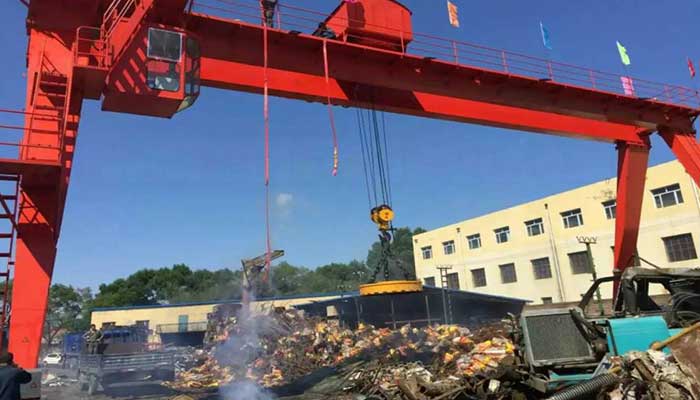
Magnetic gantry crane on tracks for steel scrap handling in steel mill plant yard
Custom Attachments for Heavy Machinery and Equipment
Tailored Solutions for Lifting Machinery:
- Specialized Lifting Configurations:Custom attachments for heavy machinery and equipment are meticulously crafted to provide tailored solutions for lifting. These attachments can include specially designed hooks, clamps, or brackets that precisely fit the contours and connection points of diverse machinery, ensuring a secure and stable lift.
- Optimized Weight Distribution:The custom nature of these attachments allows for the optimized distribution of weight during lifting operations. This is crucial when dealing with heavy machinery, as it ensures that the load is evenly distributed, minimizing stress on specific points and enhancing the overall stability of the lift.
- Support for Irregular Shapes:Heavy machinery often comes in irregular shapes and configurations. Custom attachments are designed to accommodate these irregularities, providing a snug and secure fit. This adaptability is essential for lifting machinery with unconventional or complex structures.
- Integrated Safety Features:Custom attachments prioritize safety by often incorporating integrated safety features. This can include locking mechanisms, automatic weight distribution adjustments, and sensor-based systems that provide real-time feedback to operators, ensuring safe and controlled lifting operations.
Enhancing Safety and Precision:
- Precision Control Systems:Custom attachments are integrated with precision control systems that enable operators to have fine-tuned control over the lifting process. This precision is crucial when dealing with heavy machinery, allowing for accurate positioning and placement during lifts.
- Load Monitoring and Feedback:Many custom attachments come equipped with load monitoring systems that provide real-time feedback on the weight and balance of the lifted machinery. This information empowers operators to make informed decisions, ensuring that lifts are within safe weight limits and that the load remains stable throughout the operation.
- Anti-Sway Technology:To enhance safety and precision, some custom attachments incorporate anti-sway technology. This feature minimizes the swinging of the load during lifting and movement, allowing for a more controlled and stable operation, especially when dealing with heavy and unwieldy machinery.
- Operator Training and Certification:The use of custom attachments often necessitates specialized training for operators. This training ensures that operators are well-versed in the unique features and requirements of the custom attachment, contributing to enhanced safety and precision in lifting operations.
In the realm of heavy machinery and equipment, custom attachments for gantry cranes stand as bespoke solutions, finely tuned for the lifting challenges posed by diverse machinery configurations. Join us in the next segment as we explore another type of Load Handling Device, unraveling its principles and applications in the diverse world of gantry crane operations.
Bucket Grabs and Belt Conveyors for Bulk Materials
Applications in Handling Bulk Materials like Grain and Aggregates:
- Bucket Grabs for Efficient Bulk Handling:Bucket grabs are specialized load handling devices designed for the efficient handling of bulk materials such as grain and aggregates. These grabs feature a bucket-like mechanism that can scoop and lift large quantities of loose or granular materials, streamlining the loading and unloading of bulk cargo.
- Versatility in Material Types:Bucket grabs are versatile and can be adapted for various bulk materials. Whether it's handling grains in agricultural settings or managing aggregates in construction, these devices provide a versatile solution for the efficient movement of loose materials.
- Belt Conveyors for Continuous Material Flow:In conjunction with bucket grabs, gantry cranes can be equipped with belt conveyors for continuous material flow. Belt conveyors offer a seamless and efficient means of transporting bulk materials over distances, providing a continuous flow that enhances overall operational efficiency.
- Handling Diverse Material Characteristics:The combination of bucket grabs and belt conveyors is effective in handling materials with diverse characteristics. Whether it's the fine granularity of grains or the coarser composition of aggregates, this integrated system ensures that various bulk materials can be handled with precision.
Integration of Conveyor Systems for Continuous Material Flow:
- Seamless Material Transfer:Belt conveyors integrated with gantry cranes ensure seamless material transfer from the point of loading to unloading. The continuous motion of the conveyor system minimizes interruptions, contributing to a steady and efficient material flow.
- Customizable Conveyor Configurations:Gantry cranes equipped with conveyor systems offer customizable configurations to suit specific material handling requirements. This includes adjustable conveyor angles, varying speeds, and the incorporation of additional features like weighing systems for precise material control.
- Reduced Manual Handling:The integration of belt conveyors reduces the need for manual handling of bulk materials, minimizing labor-intensive tasks and improving overall workplace safety. This is particularly beneficial in industries dealing with large volumes of materials on a regular basis.
- Enhanced Storage and Stockpiling:The continuous material flow facilitated by belt conveyors supports enhanced storage and stockpiling processes. Materials can be efficiently transported and deposited in designated storage areas, optimizing space utilization and ensuring a well-organized storage system.
In the realm of bulk material handling, the combination of bucket grabs and belt conveyors offers a powerful solution for gantry cranes. This integrated approach ensures efficient, versatile, and continuous handling of bulk materials across diverse industries. Join us in the next segment as we explore another type of Load Handling Device, unraveling its principles and applications in the diverse world of gantry crane operations.
Vacuum Lifters and Clamps for Precast Concrete
Precision Handling of Precast Concrete Elements:
- Vacuum Lifters for Contact-Free Handling:Vacuum lifters are specialized devices designed for the contact-free handling of precast concrete elements. These devices use vacuum suction to securely grip the surface of the concrete, allowing for precision lifting without the need for physical contact with the load.
- Gentle on Delicate Surfaces:Precast concrete elements often have smooth and delicate surfaces. Vacuum lifters are engineered to be gentle on these surfaces, preventing scratches, dents, or other damage during the lifting and placement process. This is crucial for maintaining the aesthetic and structural integrity of the precast elements.
- Clamps for Secure and Controlled Grasping:In addition to vacuum lifters, clamps are employed for secure and controlled grasping of precast concrete elements. These clamps are designed to securely grip the edges or sides of the elements, providing stability during lifting and precise placement during assembly.
- Adaptability to Various Shapes and Sizes:Vacuum lifters and clamps are adaptable to various shapes and sizes of precast concrete elements. Whether handling large panels, beams, or intricate components, these devices can be customized or adjusted to suit the specific dimensions and configurations of the load.
Ensuring Secure Grip and Placement:
- Adjustable Suction Pads:Vacuum lifters often feature adjustable suction pads that can be configured to match the size and shape of the precast concrete element. This adaptability ensures a secure grip on the load, preventing accidental detachment during lifting or placement.
- Variable Clamping Pressure:Clamps are equipped with variable clamping pressure settings, allowing operators to adjust the grip strength based on the weight and characteristics of the precast concrete element. This feature ensures a secure hold without causing damage to the load.
- Redundant Safety Systems:Both vacuum lifters and clamps incorporate redundant safety systems to enhance reliability. These systems may include multiple suction pads or additional clamping mechanisms to provide backup in the event of a failure, ensuring that the precast concrete element remains secure at all times.
- Precise Control Systems:Precision control systems enable operators to maneuver precast concrete elements with accuracy. This is particularly important when assembling structures where the alignment and placement of components require meticulous attention to detail.
In the realm of precast concrete handling, vacuum lifters and clamps emerge as indispensable tools for gantry cranes, ensuring the precise, damage-free, and secure handling of delicate and often irregularly shaped elements. Join us in the next segment as we explore another type of Load Handling Device, unraveling its principles and applications in the diverse world of gantry crane operations.
Advantages and Versatility of Gantry Cranes on Tracks
Flexibility in Handling Various Loads
- Ability to Adapt to Different Industries and Material Types: - Gantry cranes on tracks excel in their adaptability, catering to a wide spectrum of industries. From manufacturing and construction to logistics and recycling, these cranes showcase versatility in handling diverse materials, ensuring a seamless fit for various industrial requirements.
- Configurations for Versatile Usage: - The inherent flexibility of gantry cranes on tracks is amplified by their diverse configurations. Whether choosing between single or double girder designs, opting for specialized attachments, or configuring for indoor or outdoor use, these variations enhance the versatility of these cranes, making them adaptable to specific material handling needs.
Customization for Different Industries
- Tailoring Gantry Cranes for Specific Industry Needs: - One of the standout advantages of gantry cranes on tracks is their customization capability. Manufacturers tailor these cranes to meet the unique demands of specific industries. Whether it's integrating specialized load handling devices or optimizing lifting capacities, customization ensures that gantry cranes align precisely with the requirements of diverse sectors.
- Impact on Operational Efficiency: - The customization of gantry cranes for different industries directly contributes to enhanced operational efficiency. By aligning the crane's features and capabilities with industry-specific demands, companies can optimize their material handling processes. This, in turn, leads to increased productivity, reduced downtime, and improved overall efficiency in various industrial settings.
Efficient Material Handling in Ports, Warehouses, and Industrial Facilities
- Streamlining Operations in Port Facilities: - Gantry cranes on tracks play a pivotal role in port facilities, contributing to the efficient movement of cargo between ships and storage areas. The ability to handle containers with precision and speed makes these cranes indispensable in ports, optimizing logistics and supporting global trade networks.
- Role in Warehousing and Distribution Centers: - Warehousing and distribution centers benefit significantly from the efficiency of gantry cranes on tracks. These cranes facilitate the seamless movement of goods within warehouses, enabling swift loading and unloading of materials. Their adaptability to various load types and configurations makes them essential for optimizing storage and distribution processes.
- Versatility in Industrial Facilities: - Gantry cranes find versatile applications in a range of industrial facilities, from manufacturing plants to heavy industries. Their ability to handle different loads, coupled with customization options, makes them valuable assets for streamlining material handling processes. This versatility ensures that gantry cranes contribute to improved workflow and operational excellence in diverse industrial environments.
In conclusion, the advantages and versatility of gantry cranes on tracks extend beyond their ability to handle various loads. The customization options tailored to specific industries and their efficiency in crucial sectors like ports, warehouses, and industrial facilities underscore the pivotal role these cranes play in modern material handling. As industries continue to evolve, gantry cranes on tracks remain at the forefront, adapting to the ever-changing landscape of global logistics and manufacturing.
Considerations for Gantry Crane Selection
Load Capacity and Span
- Determining Appropriate Load Capacities for Specific Applications: - Gantry crane selection begins with a meticulous assessment of the loads it will handle. Understanding the weight, dimensions, and frequency of lifting is crucial in determining the crane's load capacity. This ensures optimal performance without compromising safety or efficiency in material handling operations.
- Considerations for Gantry Crane Spans: - The span of a gantry crane, defined as the distance between the crane's supporting legs, is a critical factor in selection. The span must align with the layout of the workspace and the required coverage areCareful consideration of span ensures that the crane effectively covers the designated work zones, minimizing the need for repositioning.
Operational Environment (Indoor vs. Outdoor)
- Adapting Gantry Cranes for Indoor and Outdoor Environments: - Gantry cranes are versatile in their adaptability to different operational environments. For indoor settings, considerations include ceiling height, floor space, and restrictions posed by existing structures. In outdoor environments, resistance to weather elements and exposure to varying temperatures become pivotal factors in crane design and material selection.
- Impact of Environmental Factors on Crane Performance: - Environmental factors such as humidity, temperature fluctuations, and exposure to corrosive substances can affect the performance and longevity of gantry cranes. Selection must account for these variables, leading to the incorporation of protective measures, corrosion-resistant materials, and weatherproofing to ensure consistent and reliable crane operation.
Special Features for Specific Applications
- Integration of Specialized Features for Unique Handling Requirements: - Certain applications demand specialized features to optimize material handling. Gantry cranes can be equipped with attachments like spreader bars, magnets, or clamps tailored for specific loads. These features enhance precision, efficiency, and safety in handling materials ranging from delicate components to heavy machinery.
- Examples of Tailored Features in Specialized Gantry Cranes: - Specialized gantry cranes for industries like steel manufacturing may feature electromagnetic attachments for efficient handling of steel coils. In contrast, those in the automotive sector may incorporate custom lifting configurations to handle large vehicle components. Tailored features align the crane with the unique demands of each application, maximizing its utility.
Safety and Compliance Standards
- Importance of Adhering to Safety Regulations: Safety is paramount in gantry crane operations. Adherence to industry-specific safety regulations and standards is non-negotiable. Gantry crane selection must prioritize designs that comply with international safety standards, ensuring the protection of personnel, equipment, and the materials being handled.
- Certifications and Standards for Gantry Crane Safety: Recognized certifications, such as CE marking and compliance with ISO standards, signify that a gantry crane meets stringent safety and quality criteriThese certifications instill confidence in crane operators and owners, assuring them that the equipment has undergone rigorous testing and complies with global safety benchmarks.
In the realm of gantry crane selection, a comprehensive evaluation considering load capacities, spans, operational environments, specialized features, and safety standards is imperative. By aligning the crane's specifications with the unique demands of the application, industries can ensure optimal performance, longevity, and, most importantly, the safety of their material handling operations.
Custom Gantry Cranes on Tracks for Your Needs And Applications
- Summary of Gantry Crane Versatility and Applications: Gantry cranes, with their diverse types and configurations, stand as versatile workhorses in the realm of material handling. From single girder cranes suitable for moderate loads to heavy-duty double girder cranes handling massive weights, the spectrum of applications spans across industries such as manufacturing, construction, logistics, and more.
- Notable Contributions to Efficient Material Handling: The recap highlights the significant contributions of gantry cranes to efficient material handling. Their adaptability to various loads, customized features, and adherence to safety standards collectively contribute to streamlined operations, improved productivity, and enhanced safety in a wide range of industrial settings.
Future Trends and Innovations in Gantry Crane Technology
- Emerging Technologies in Gantry Crane Design and Automation: The future of gantry cranes is marked by the integration of cutting-edge technologies. Automation, IoT (Internet of Things), and sensor technologies are poised to play pivotal roles. Smart gantry cranes equipped with advanced control systems and real-time monitoring capabilities will redefine efficiency and precision in material handling operations.
- Anticipated Advancements in Gantry Crane Industry: As industries continue to evolve, the gantry crane industry is expected to witness advancements in material science, structural design, and energy efficiency. Lightweight materials with enhanced strength properties, innovative structural configurations, and eco-friendly power sources are anticipated to be key areas of development, ensuring sustainable and technologically advanced gantry crane solutions.
- In conclusion, the recap of gantry crane types and applications underscores their versatility and indispensable role in modern material handling. As we look toward the future, the anticipated trends and innovations in gantry crane technology promise to further elevate the efficiency, safety, and sustainability of material handling operations across diverse industries. The gantry crane industry stands at the cusp of transformative advancements, ready to meet the evolving demands of the global industrial landscape.
Main Projects
Related Products

Latest project
32/5 Ton Overhead Crane Sale in India: Case Study
Free consultation to Confirm Parameters & Specifications and Get
Latest Crane Price & Crane Rate.
- Types of overhead cranes : _______?
- Optional: Overhead travelling crane, goliath gantry crane,Slewing jib crane, Single girder or double girder crane,small portable crane or kbk crane, etc.
- Capacity of overhead crane: _______?
- Optional: 0.25ton, 0.5 ton, 1 ton, 2 ton, 3ton, 5 ton, 10 ton,15ton, 20ton, 25 ton, 30ton,35ton, up to 550ton, etc.
- Crane span & lifting height : _______?
- Crane travelling length : _____?
- Control of overhead crane:_______?
- Optional: pendant/ remote/cabin control
- Voltage supply of overhead crane:_____?
- Eg,: 380V50/60HZ,3Phase or others,etc.
- Application/usage of crane:_______?
- Eg,: Steel mill, ,injection mold, cement,stone, concrete,granite, general manufacturing, etc.
Just leave a message via the contact form and our hoist and crane engineer will contact you with in 24working hours.
Get In Touch
